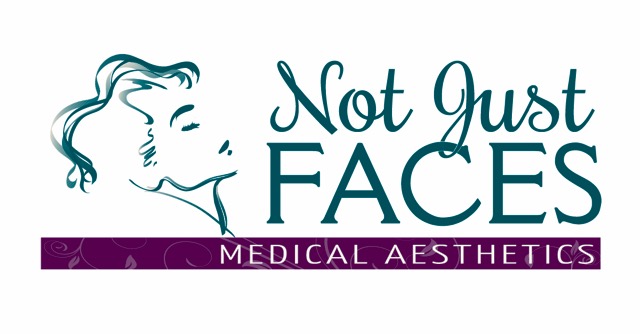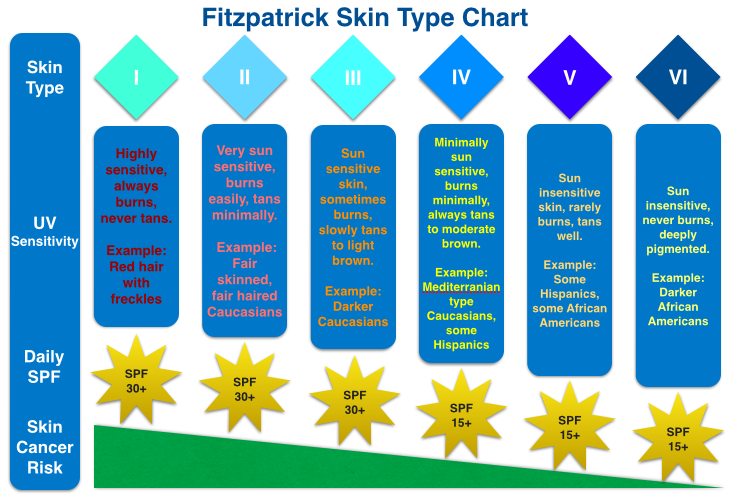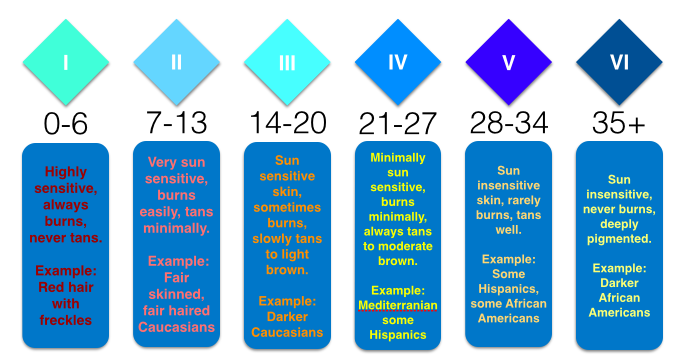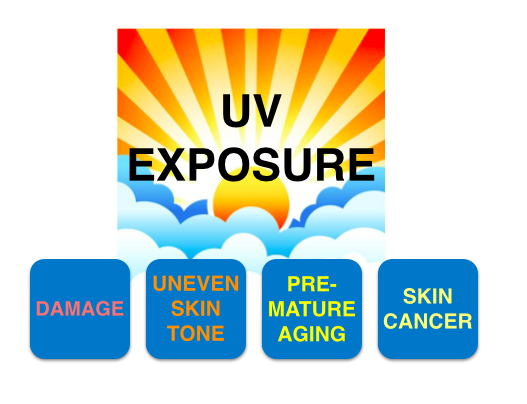Think You Know Your Skin Type? Take the Fitzpatrick Skin Type Test!
It’s tempting to take a look at the scale and think you know exactly where you sit on the spectrum of Fitzpatrick Skin Types. Is there a chance you may be wrong? Always check with your skincare professional before doing any treatments, but this quick quiz can give you a starting point to understanding what’s best for your skin. Fitzpatrick Skin Quiz
What is the Fitzpatrick Scale?
The Fitzpatrick Scale (also Fitzpatrick skin typing test or Fitzpatrick phototyping scale) is a numerical classification schema for the color of skin. It was developed in 1975 by Thomas B. Fitzpatrick, a Harvard dermatologist, as a way to classify the response of different types of skin to UV light. Later, it was updated to also contain non-white skin types. It remains a recognized tool for dermatologic research into the color of skin. [Source]
What are the Fitzpatrick Skin Types?
This graphic walks through your skin type based on your test score:
So you have your Fitzpatrick Skin Type number — what does that mean?
For ALL Skin Types:
Minimize sun damage through daily use of a broad spectrum SPF – this includes staying out of the sun during peak hours and reapplying sunscreen throughout the day. UV exposure is always damaging and leads to uneven skin tone, premature aging, and skin cancer in ALL skin types.
Implement (or stick to) a daily skin care regimen:
Cleanse (and exfoliate) according to your skin type. 2-3 times a week for normal to oily skin, 1-2 times a week for acne prone or sensitive skin. If you find your skin drying out or getting irritated, back off of exfoliants until your skin balances out.
Correct using a serum or retinol product that fits your skin. This step could be for anti-aging, or extra hydration. Talk with your skin care professional to find the serum that works best for your skin type of skincare goals.
Nourish/Hydrate – moisturize after each cleanse. Wait at least a few minutes between your serum or “correct” step. This will allow the product to penetrate your skin and get to work.
Protect – make sure your sunscreen is labeled broad spectrum and that you reapply during the day. (Immediately upon sweating or swimming) If you are in a sunnier climate, regardless of your skin type, wear SPF 30+ every day.
The following ingredients are good for all skin types:
- Vitamin C – great for lightening (pigmentation) and hydration, slows the rate of free-radical damage — free radicals are unstable molecules that damage collagen and cause skin dryness, fine lines and wrinkles, may also reduce sunburn caused by exposure to ultraviolet B radiation and prevent the consequences of long-term sun exposure
- Vitamin E – plays important roles in photoprotection, preventing UV-induced free radical damage to skin. Vitamin E may also have related anti-inflammatory roles in the skin
- Green Tea – soothes the skin, quenches free radicals and reduces inflammation caused by sun exposure
- Aloe Vera – soothes sunburn, moisturizes the skin, reduces redness and general skin inflammations, and contains a plethora of antioxidants including, beta carotene, vitamin C and E that can help improve the skin’s natural firmness and keep the skin hydrated
What are the biggest areas of concern for each Fitzpatrick Skin Type?
Type I – Type I skin types are at the highest risk of skin cancer and they produce the most pheomelanin. Pheomelanin is a type of melanin produced that has a higher risk for skin cancer. The more your skin is exposed to UV radiation, the more pheomelanin is produced.
Type II – Type II skin types are also in the category more likely to develop skin cancer
Type III – Still above average in the risk category for skin cancer.
Type IV – Less of a risk of skin cancer, but skin tends to produce more melanin following sun exposure. Could lead to melasma – brown to gray-brown patches on the face. Most people get it on their cheeks, bridge of their nose, forehead, chin, and above their upper lip. It also can appear on other parts of the body that get lots of sun, such as the forearms and neck. Could also be affected by oral contraceptives and pregnancy. Sunscreen alone may not be enough to prevent melasma, so throw on a hat and sunglasses if you can. Skin Type IV is at medium risk for skin discoloration, blotchiness, darkening or lightening, burns and scarring.
Type V – Although the risk for skin cancer is significantly less in type V and VI skin types, sun exposure is always damaging and can lead to uneven skin tone and pigmentation. With this skin type, the skin reacts differently and sometimes severely to acne, eczema, dermatitis, psoriasis, and dandruff. The skin is also more reactive to insult and keloid scarring. Don’t over cleanse or over exfoliate type V skin. Use a gentle exfoliant, and always do a test patch of the skin.
Type VI – Like Type V skin, there is a greater chance for problems with insult and scarring. Darker skinned races are also at risk for Acral Lentiginous Melanoma – a type of melanoma that occurs without exposure to UV light. ALM is sometimes ignored or mistaken for an injury or a nail fungus. Because this particular form of melanoma is often misdiagnosed or ignored, it is often more deeply invasive when it is finally discovered. It can start on the soles of the feet, palms, between toes and fingers, and under nails. Do a full body check monthly and be sure to seek out professional care if you notice any of these marks.
Check out this great article on Melanoma in People of Color
What type of sunscreen you should use for your skin type?
For ALL skin types:
Avoid direct sun exposure during peak hours (10 am – 4 pm), wear protective clothing, hats, sunglasses
Use SPF 50+ if you must be in direct sunlight, reapply every 90 minutes (or directly after sweating or swimming)
If you are in a hotter climate (closer to the sun) wear a broad spectrum sunscreen of at least SPF 30
- Type I – Daily use of SPF 30, reapply around lunch time, avoid as much direct sunlight as possible
- Type II – Daily use of SPF 30
- Type III – Daily use of SPF 15+
- Type IV – Daily use of SPF 15+
- Type V – Daily use of SPF 15+
- Type VI – Daily use of SPF 15+
REMEMBER – No matter what skin type you have, a broad spectrum sunscreen is essential for your skin health — and health in general. Just because you are less likely to develop skin cancer due to UV radiation, it doesn’t mean you can’t. Don’t skimp on the sunscreen!!!
What types of facial treatments are best for your skin type?
- Smoothers (Dysport/ Botox) & Fillers (Juvederm, Restylane, etc.) work well on all skin types
- Microdermabrasion is considered safe for all skin types
- Surface chemical peels are safe for all skin types. As you move toward type IV, V, and VI, mid-dermal to deep peels are not recommended.
- Laser treatments can be safe for all skin types. The lighter the skin tone, the less chance for problems with laser treatments, although Types IV, V and VI may be safely treated. Type IV, V, and VI should ONLY be treated by a licensed medical professional that would be considered “experienced” in treating those skin types. Care should be taken with all skin types, but the higher Fitzpatrick Skin Types have a greater chance of hyper pigmentation and other complications. (Poor quality control and a general lack of training led to a common misconception about darker skin types and laser treatments.)





